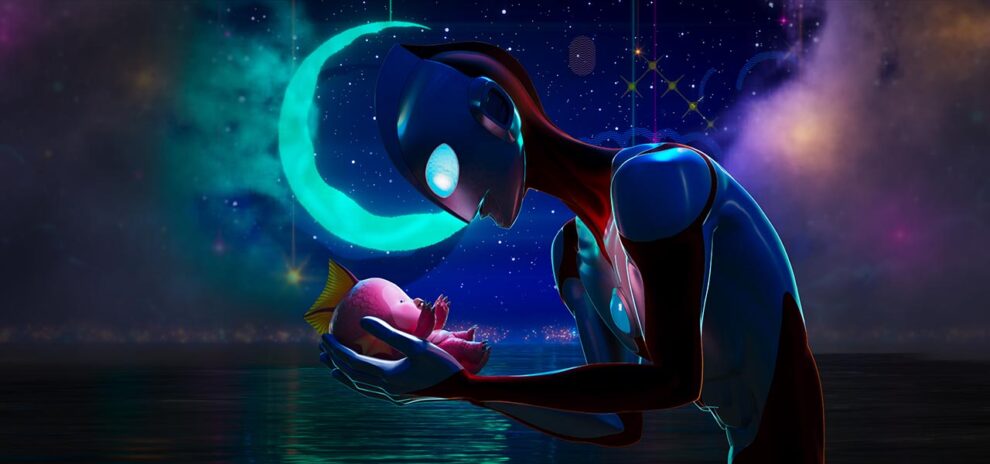While “Ultraman” is primarily known as a prominent figure in television, films like Kazuya Konaka's “Ultraman: The Next” and Shinji Higuchi's “Shin Ultraman” have shown that the beloved superhero can work well within a movie format. The fictional icon's latest cinematic outing, the Japanese-American animated co-production “Ultraman: Rising,” brings together quite a team. Netflix Animation and Tsuburaya Productions collaborate with animation by Industrial Light & Magic (ILM), originally founded by filmmaker George Lucas. Making his directorial debut is Shannon Tindle, a prominent animation designer whose work includes on shows like “Samurai Jack” and movies such as “Kubo and the Two Strings.” He also writes the screenplay alongside Marc Haimes. John Aoshima is co-directing with Tindle, who similarly has an experienced animation resume, including on the hit comedy series “Futurama.” These creative minds come together and deliver a visually astonishing, if rather formulaic, family feature.
Click the image below to follow our Tribute to Netflix

After spending extensive time overseas, egocentric baseball player Kenji “Ken” Sato returns to Japan to continue his sports career. Additionally, he secretly assumes the role of the gigantic legendary superhero Ultraman, who protects the country when giant monsters threaten it. Yet, things aren't all bright for Sato as he is responsible for being a professional athlete and is reluctant to fulfill his duties as a hero. These responsibilities are not helped by his relationship with his estranged father following the disappearance of his mother. Yet, it's about to become much harder because, after battling his latest opponent, Gigantron, Ken finds himself caring for a baby kaiju, eventually named Emi.
It should be addressed that “Ultraman: Rising” as a film cannot and frankly shouldn't be compared to the tokusatsu icon's previous cinematic outing, “Shin Ultraman.” Both are very different and aim to tell their own stories with relevant themes to their narratives while also being geared towards polar opposite demographics. As is, it's best to look at “Rising” on its own merits, and for what it is, it's perfectly fine. It's a cute film that delves into themes of found family and familial reconciliation, which are surely topics moviegoers can latch onto, fans of Ultraman or not. Yet, much of what is showcased here is a rehashed culmination of many frequently reutilized tropes depicted in countless family movies. Such cliched narrative elements include:
- The main character is caring for an orphaned baby.
- A superhero has to bear the responsibility of heroism, gradually growing through personal turmoil.
- The lead's family life is torn apart by tragedy.
- A witty sidekick to play off the protagonist's frustrations
- A villain with a personal grudge against the hero.
Familiarity is not automatically bad, yet the filmmakers don't do much with these story threads to help distinguish it from similar features, minus the fact that the Ultraman brand is slapped on and involves kaiju. It plays out very predictably. Similar criticism can be directed at the writing, which isn't terrible but is not great either. Most of the dialogue is very spelled out for viewers, which can sometimes become frustrating. The characters are fairly standard and never truly feel that complex beyond their surface-level traits and personas, playing into how formulaic the conflicts are in their presentation and eventual resolution, especially in the movie's third act. Furthermore, the movie could have done more with its world-building.
However, there are still elements to admire about “Ultraman: Rising.” The baby kaiju Emi is adorable and thankfully never becomes an insufferable character that viewers are forced to deal with alongside Ken. The movie's core message of balancing and adapting to life's responsibilities and gradually becoming a better person can strike a personal chord for younger and older audiences alike. The way the picture approaches some topics involving Japanese culture is surprisingly bold for a family picture. This includes Ken being initially ostracized by his teammates when he returns to Japan due to spending significant time overseas, likely due to nationalistic ideology. The theme of balancing various responsibilities while trying to have a family life is also very true to lifestyle in Japan, as is how different generations view certain topics.
Check also this video
Some of the movie's best scenes are when Ken opens up with the other characters. There's a great scene within the middle section where our lead is at dinner with another character who slowly helps him open up about his conflicting feelings toward his father while maintaining his public persona. Additionally, there's another nice moment where Ken shares an earnest exchange with his father about his childhood while sitting at a campfire. While the cutesy sections with the baby monster Emi can be amusing, and some of the humor occasionally lands, these sections stand out as undoubtedly the strongest scenes of the entire film.
Additionally, there are some fun easter eggs that longtime fans of tokusatsu will surely get a kick out of. Perhaps one of the most charming ones is when the baby kaiju Emi does a happy dance reminiscent of a happy pose from the manga series “Osomatsu-kun,” which was famously referenced with Godzilla's victory dance in “Invasion of Astro-Monster.” Longtime Ultraman fans will also surely get a kick out of the appearance of the fan-favorite kaiju Neronga. Perhaps one of the most subtle references is when a family sings the English dub version of the theme song from the classic 1966 “Ultraman” series.
While these characters are fairly average, the voice cast does a good job here. Christopher Sean adds believability to his performance as Kenji “Ken” Sato as he bears all these responsibilities, whether baseball, heroism, or parenting. He initially comes off as egotistical and selfish, but he gradually becomes a better person. Additionally, while successful in making the character cocky, he knows when to dial things down for the more dramatic moments, which is never easy in voice acting. Some of the best parts of Sean's performance come from his interactions with his co-stars, such as Julia Harriman as sports reporter Ami Wakita, who, through their interactions, help bring out the character's humanity. The same goes for Gedde Watanabe as the protagonist's father, Professor Sato, and Tamlyn Tomita, who plays the hero's witty AI sidekick, Mina, along with his mother, Emiko Sato. While Dr. Onda could have used more depth to make him a compelling, tragic villain, Keone Young truly gets the job done.
No doubt, the film's strongest suit is the animation, which is gorgeous. Industrial Light & Magic (ILM) outdid themselves here. While the art style is perhaps quite derivative of the visual direction of the “Spider-Man Spider-Verse” films, it's still a beautiful-looking movie nonetheless. Ultraman's design here is a nice update of the classic 1966 design, including adding the hero's color timer. Also commendable is the attention to detail in making the characters expressive and feel alive. The action scenes are well done, and Scot Stafford's music score is fairly decent.
“Ultraman: Rising” is not a bad movie; it's cute and inoffensive, offering enough entertainment for a family viewing, yet it feels very safe and somewhat corporate. Its animation is gorgeous, and there is a clear love for the “Ultraman” property, offering occasional amusing fanfare. Yet, more than these are needed to make it truly stand out. As is, viewers are presented with a story reliant on numerous recycled family movie tropes, only occasionally giving surprises. With that, it's a decent animated superhero flick entertaining enough for younger audiences, though it's only guaranteed to click with some longtime fans of the franchise.













